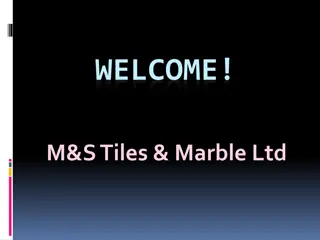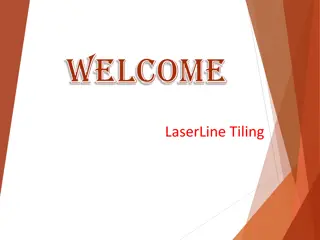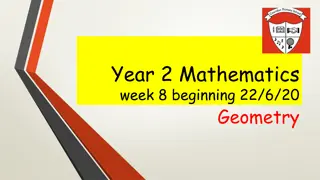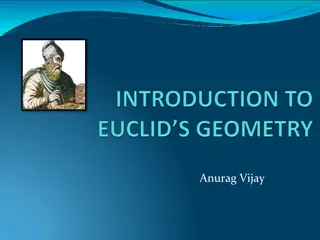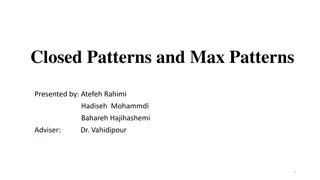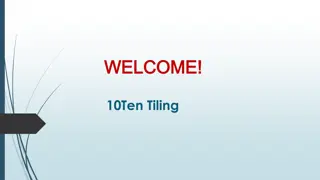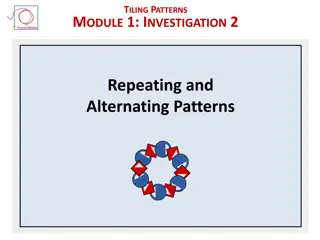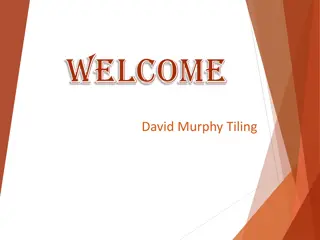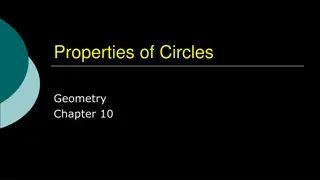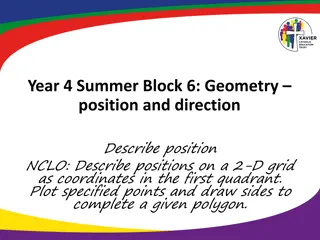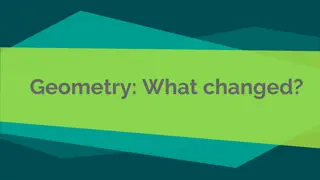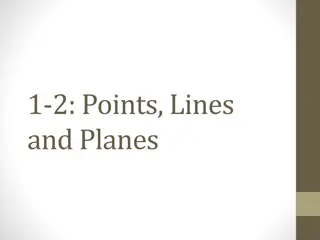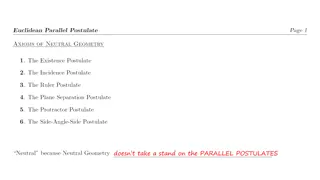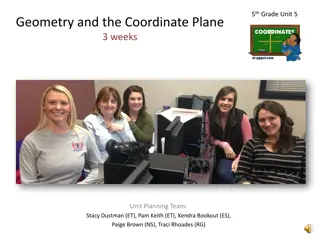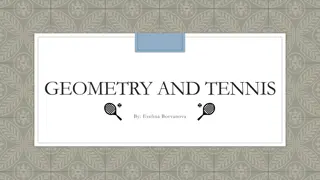Exploring Hyperbolic Geometry and Tiling Patterns
Dive into the fascinating world of hyperbolic geometry, where angles in a triangle are less than 180 degrees and tilings exhibit negative curvature. Discover the beauty of the Hyperbolic Plane and learn about regular hyperbolic tilings characterized by Schlafli Symbols. Explore different models like the Half-Plane Model and the Cayley Map that help visualize hyperbolic spaces. Understand how interior angles differ in hyperbolic, Euclidean, and spherical geometries and uncover the unique properties of hyperbolic tiling patterns.
Download Presentation

Please find below an Image/Link to download the presentation.
The content on the website is provided AS IS for your information and personal use only. It may not be sold, licensed, or shared on other websites without obtaining consent from the author. Download presentation by click this link. If you encounter any issues during the download, it is possible that the publisher has removed the file from their server.
E N D
Presentation Transcript
Isabel Beach University of Toronto The Beauty of the Hyperbolic Plane
Image credit: https://en.wikipedia.org/wiki/List_of_regular_polytopes_and_compounds Regular Euclidean Tilings Only 3! Polygon angles must add up to 360 at each vertex
Hyperbolic Space Negative Curvature (not flat!) Angles in a Triangle add up to < 180 Can fit more polygons into our tilings Image credit: https://en.wikipedia.org/wiki/Hyperbolic_geometry
The Half-Plane Model Complex numbers with positive imaginary part Curvature is determined by the hyperbolic metric: d?2= ?2d?2+d?2 Distance grows exponentially as we approach the real line 1 Image credit: Caroline Series
? ? ? ? + ? The Cayley Map Maps upper half-plane bijectively onto unit disk Maps real-line into the unit circle Preserves angles and distances Converts plane model to a disk model ( The Poincar Disk Model )
Regular Hyperbolic Tilings Tilings are characterized by Schl fli Symbols p = # of sides of each tile q = # of polygons meeting at each vertex Example: Euclidean square tiling is (4,4) Which Schl fli Symbols are hyperbolic? Schl fli Symbols (p,q):
Regular Hyperbolic Tilings Interior angles of regular polygon with p sides: = ? ? 2 /p (in Euclidean space) In hyperbolic geometry, will be lower In spherical geometry, will be higher Total angle at vertex with q polygons: ? = ? = ?? ? 2 /? lower higher
? ? 2 /? p 6 3 4 5 7 8 9 3 4 5 6 7 8 9 1 1.5 1.8 2 2.14 2.25 2.33 1.33 2 2.4 2.67 2.86 3 3.11 1.67 2.5 3 3.33 3.57 3.75 3.89 q 2 3 3.6 4 4.29 4.5 4.67 2.33 3.5 4.2 4.67 5 5.25 5.44 2.67 4 4.8 5.33 5.71 6 6.22 3 4.5 5.4 6 6.43 6.75 7
Regular Hyperbolic Tilings Spherical: ?? ? 2 /p < 2? 5 choices, corresponding to the 5 platonic solids Euclidean: ?? ? 2 /p = 2? 3 choices, corresponding to our original 3 regular tilings Hyperbolic: ?? ? 2 /p > 2? Infinitely many choices! For any p, just pick q large enough
We can always find a hyperbolic p-sided polygon with arbitrarily small interior angles Can always fit in more tiles at each vertex
Now we know which polygons we can use. But which transformations can we use?
Regular Hyperbolic Tilings Like in the Euclidean example, want our tiles to be congruent. Translations, rotations, reflections Isometries Isometries What is the hyperbolic equivalent?
Mobius Maps ? ?? + ? ?? + ? ? ? ? ? 2x2 matrices give rise to maps of the complex plane
Mobius Maps Mobius maps with real coefficients and determinant 1 are the isometries (distance-preserving maps) of the hyperbolic plane This group is called PSL(2, ) ( Projective Special Linear Group ) ( Projective means we identify the matrices A and A, which give the same Mobius map) ? ? ? ? | ?,?,?,? , ?? ?? = 1 PSL(2, ) =
Classification by Fixed Points ?? + ? ?? + ?= ? 0 = c?2+ ? ? ? ? ? ?2+ 4?? 2? ? ? ? = Recall: ?? ?? = 1 ? ? Trace2 4 2? = The number of fixed points is determined by the trace (a+d).
Classification by Fixed Points Map Name Trace Fixed Points Elliptic |Trace| < 2 2 Complex (1 in upper half plane) Parabolic |Trace| = 2 1 Real Hyperbolic |Trace| > 2 2 Real
Elliptic |Trace| < 2 2 complex conjugate fixed points Analogous to rotation (on a sphere)
Fixed Point at red star
Hyperbolic |Trace| > 2 2 real fixed points Analogous to scaling
Fixed Point Fixed Point
Parabolic |Trace| = 2 1 real fixed point Analogous to translation
Fixed Point
Examples of Regular Hyperbolic Tilings
Ideal Polygons: Vertices at infinity Symbol (p, )
Before, I started with a polygon and applied certain isometries to make a tiling. If I start with a bunch of isometries, when can I find a polygon that will produce a tiling?
Definition: A Fuchsian Group Fuchsian Group is A subgroup of PSL(2,R) Acts properly discontinuously properly discontinuously on hyperbolic space Each point has a neighborhood such that almost every map in our group sends that neighborhood far away Within PSL(2,R), this is equivalent to being a discrete subgroup! Tiles nicely Groups of Isometries: Fuchsian Groups!
Possible to pick an initial tile, or fundamental domain fundamental domain, such that: The initial tile is a (possibly non-regular) polygon Tiles don t overlap or get repeated Tiles cover the entire space Only finitely many tiles meet at any point (except maybe on the boundary) Groups of Isometries: Fuchsian Groups!
PSL(2,Z) Every isometry of the disk with integer coefficients Generated by 2 elements: S: ? 1/? T: ? ? + 1 Group presentation is: ?? | ?2= ?, ??3= ?
PSL(2,Z) The group presentation is shown in the tiling! ??3= ?, so after flipping and rotating 3 times, we come back to our original tile This fact generalizes as Poincar s Theorem
A Punctured Torus Group Two transformations: ? ? + 1 ? + 2 ? 1 ? + 2 ?
Why Punctured Torus Group? Tilings can also produce quotient spaces of the hyperbolic plane 2 points are identified if an isometry in the tiling maps one to the other Imagine gluing together the edges of our initial tile polygon Hyperbolic Surfaces
Image credit: http://pi.math.cornell.edu/~mec/Winter2009/Victor/part1.htm Example: Square and hexagon tiles can make a torus* *Actually, the quotient space omits the corners of the tile at infinity, so we get a torus with a hole. The normal torus does not admit a hyperbolic structure!
The Future: Weird Things I Don t Know How To Code (Yet!) Infinite-sided polygon tilings (Symbol ( ,p)) Semi-regular tilings Orbifold groups Higher Dimensions (Quasi-Fuchsian Groups) Image credit: https://en.wikipedia.org/wiki/Uniform_til ings_in_hyperbolic_plane
Title slide: M. C. Escher, Circle Limit IV Euclidean tilings, hyperbolic surface picture, spherical triangle, Weird Stuff slide: Wikipedia/Wikimedia Commons http://pi.math.cornell.edu/~mec/Winter2009/Victor/part1.htm Torus Gluing: http://pi.math.cornell.edu/~mec/Winter 2009/Victor/part1.htm Image Credits http://pi.math.cornell.edu/~mec/Winter2009/Victor/part1.htm http://ibeach.github.io Everything Else: Made in MATLAB by me http://ibeach.github.io
Further Reading Wikipedia (for more pictures) https://en.wikipedia.org/wiki/ Uniform_tilings_in_hyperbolic _plane Hyperbolic geometry notes by Caroline Series Indra s Pearls by Caroline Series and David Mumford Orbifold Group (2,3,10) ?!



